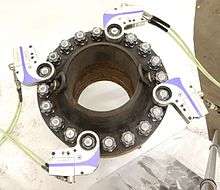Hydraulic torque wrench


A hydraulic torque wrench is a power tool designed to exert torque on a fastener to achieve proper tightening or loosening of a connection through the use of hydraulics. A torque wrench is applied to the nut either directly or in conjunction with an impact socket. Hydraulic torque wrenches apply a predetermined, controlled amount of torque to a properly lubricated fastener.
The hydraulic torque wrench was invented by George A. Sturdevant in Houston, Texas. The concept of a hydraulic powered torque wrench was first introduced on the market sometime in the early 1960s in a primitive form, and several key advances have been developed by manufacturers since that time which provided major advancements in the technology and usability of the tools far beyond the original concept tool.
Today's tools offer benefits such as lighter weights, smaller nose radius dimensions for fitting into tight spaces, use of exotic alloys, actuation triggers on the tool itself, multi-position reaction members, 360° × 360° hose swivels, and the ability to run multiple tools simultaneously from a single power pack.
The main characteristics of a hydraulic torque wrench which set it apart from other powered wrenches of similar function are that (1) it must generate torque using only hydraulic means (2) it must be self ratcheting, and (3) it must include an accurate method of determining the amount of torque applied.
In 1985, the Bolt Council : Research Council on Structural Connections, aka RCSC, specification permitted the use of the calibrated wrench method of installation, but with a clearer statement of the requirements of the method and its limitations.
In the calibrated wrench method the wrench is calibrated or adjusted to shut off when the desired torque is reached. In practice, several bolts of the lot to be installed are tightened in a calibrating device that directly reads the tension in the bolt. The wrench is adjusted to shut off at bolt tensions that are a minimum of 5% greater than the required preload. [1]
Some manufacturers utilize a holding pawl design to keep the wrench locked in position prior to each power stroke, others use varying designs, which as in all industries have debatable faults or claimed advantages.
Hydraulic torque wrenches typically offer accuracy of ±3% and have a high degree of repeatability making them well suited to applications where large bolts are involved and a high degree of accuracy is required[2].
A hydraulic torque wrench is significantly quieter, lighter weight and more accurate than pneumatic impact wrenches capable of similar torque output, making it an appealing alternative for many users to the very loud and cumbersome impact wrenches or torque multipliers which were formerly the only viable option for working with very large nuts and bolts until the hydraulic torque wrench was introduced.
Bolt tensioners are an alternative to hydraulic torque wrenches, but, not as commonly used.
Reaction arm free torque wrenches

The most dangerous part of a hydraulic torque wrench is the reaction member, often called reaction arm. When torque is applied to the bolt or nut, the reaction member abuts against a stationary object to stop the wrench from turning around the fastener. This reaction force is tremendous and accidents (for example pinched fingers) have happened more than once.
Since 2014 it is possible to torque tighten bolts without the use of a reaction arm, and thus without pinch point. This is a great break-through in the industry. Reaction arm free torqueing is possible due to the usage of a reaction washer. The knurled side of the washer hold on to the construction/flange and the bolt or nut turn over a smooth and through-hardened surface. The reaction washer will become a stationary object underneath the nut, eliminating the use of reaction arms.
See also
References
- ↑ |url=http://www.boltcouncil.org/files/2ndEditionGuide.pdf | title=Recommended Erection and Field Inspection Procedures for High-Strength Bolts |chapter=4 |section=3 |chapter heading=Installation of high-strength bolts |page=53
- ↑ "When to Use a Hydraulic Torque Wrench". MaxProCorp.com.
External links
| Wikimedia Commons has media related to Torque wrenches. |